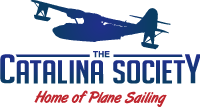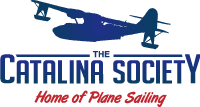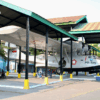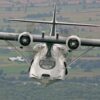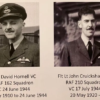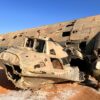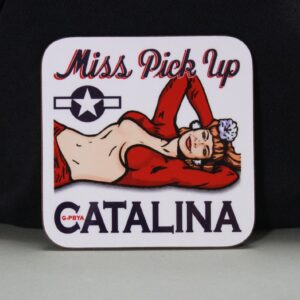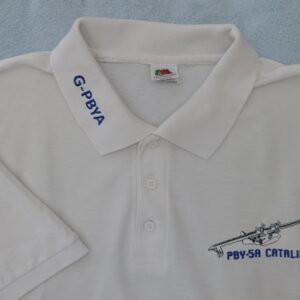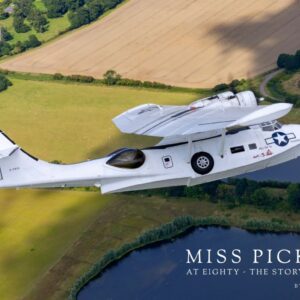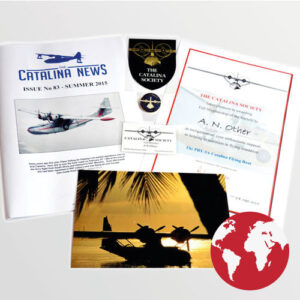The PBY Catalina series of flying boats was originally conceived to meet a military requirement and its development built on Consolidated’s experience with earlier flying boat designs. These earlier types had included the commercial Model 16 Commodore and the military Model 22 Ranger/P2Y series.
The Commodore was itself a development of the Model 9 Admiral, or XPY-1 to give it its US Navy designation. The XPY-1 was designed as a US Navy flying boat with the capability of linking the United States West Coast with Hawaii. It was a metal twin-engined monoplane – the first US Navy monoplane seaplane – with a crew of five, the two pilots being in an exposed cockpit, the navigator in the bow, the radio operator in the centre section and the engineer aft. Armament consisted of one 0.30 in machine gun forward of the cockpit and two further 0.30 in guns in an open area further back along the upper hull. Power came from two 450 hp Pratt & Whitney R-1340-38 Wasp engines, although, later, a third engine was installed above the wing. The XPY-1 first flew on 10th January 1929, from Anacostia in Maryland, but it was destined to be a limited edition of one, the Navy ordering the cheaper Martin XP2M and P3M flying boat instead. The solitary Admiral was given the military
serial A-8011.

The start of the line – the Model 9 Admiral or XPY-1 Photo: David Legg Collection
Although the Admiral was not a success in terms of military orders, it did give rise to interest from the commercial sector, and this led to the Consolidated Model 16, or Commodore. Design changes included more powerful engines in the shape of two Pratt & Whitney R-1860 Hornets Bs of 575 hp each and a hull that could accommodate up to 32 passengers in some luxury. Initially, it had been hoped that the new type would be sold to the Detroit and Cleveland Navigation Company, which had plans to use the Commodore between destinations around Lake Erie, and to Pan American Airways, but in the event no orders materialised. However, orders did come from Tri-Motor Safety Airways, which wanted to use the type to link North and South America. The prototype first flew on 28th September 1929, and in due course fourteen were built at the Consolidated factory at Buffalo, New York. All those built operated with the launch customer, which, by the time of the first delivery, had been renamed New York, Rio & Buenos Aires Line, or NYRBA, only to be merged with Pan American in September 1930. Production of the Commodore ceased in the following November.
Although the fact that Consolidated’s founder Reuben Fleet was directly involved in the management of NYRBA clearly enabled his company to produce and sell his own design, the Commodore none-the-less indicated that Consolidated was able to build a successful flying boat for commercial use. The next flying boat to be built by the company, however, was another design for the military.
Again based on the earlier, unsuccessful Model 9 Admiral monoplane flying boat, the Model 22 Ranger shared the same upper wing but also incorporated a lower, shorter-span wing supporting the two floats. It too had a covered cockpit for the flight crew as on the Commodore, and it was at first powered by three Wright R-1820E Cyclones of 575 hp, later reduced to two. Given the US Navy designation XP2Y-1 and serial Bu8939, the initial example took to the air for the first time on 26th March 1932.
Consolidated went on to produce another 23 twin-engined P2Y-1s for the US Navy, and these were allocated serials Bu8986 to 9008. The final aircraft was completed in June 1933, and was modified a few months later to become the first PY2-2 powered by two 750 hp R-1820-88s. These engines were mounted upon the wing leading edge rather than between the hull and the upper wing as on the P2Y-1. Nearly all of the latter were subsequently upgraded to P2Y-2 standard. The two unconverted aircraft were exported, one to Colombia for air force use and the other to Japan. Incredibly, the South American aircraft remained in service until as late as 1948, by which time it had been supplemented by a number of Catalinas. The Japanese example was used commercially during World War Two.
There followed a further 23 P2Y-3s (Bu9551 to 9571 and 9618 to 9619) of similar configuration to the P2Y-2 but with uprated R-1820-90 engines and greater fuel capacity. A further six were produced to meet an Argentine Navy order in mid-1936, and these flew on until 1947 when, like the Colombian P2Y-1, they were replaced by Catalinas. The US Navy aircraft were used by various patrol squadrons, and many ended up at NAS Pensacola in Florida, where they were used to train flying boat crews, including many who were later to become RAF Catalina personnel.

A twin-engined P2Y-3 at San Diego showing the high strut-mounted wing and much shorter shoulder-mounted lower wing with floats attached Photo: David Legg Collection
The Commodore and Ranger designs only bore a passing resemblance to the PBY inasmuch as the side profile of the lower hull and step were similar. Both types showed evidence of reliability and the capability of long distance flight for both military and commercial users, and it was whilst the early examples of the P2Y series were being produced that the Consolidated designer, Isaac Laddon, began design work on what was to eventually become the Consolidated Model 28/PBY Catalina series.
This design was known initially by its military designation XP3Y-1, and was prompted by a 1933 United States Navy contest inviting manufacturing companies to submit entries to meet the requirements for a military patrol flying boat with an operational range of 3,000 miles and a cruise of 100 mph. Consolidated submitted its design and the US Navy liked what it saw. Reuben Fleet’s company was rewarded with a contract to build one aircraft at the end of October 1933. Rival firm Douglas had previously been given a similar contract to develop its own submission – the XP3D-1; indeed, the Douglas aircraft was the first to fly, beating the Consolidated aircraft off the water by more than a month.
Isaac Laddon incorporated a number novel features into his XP3Y-1 layout, in particular the pylon-mounted parasol wing and the retractable floats that changed the flying boat’s wingspan in flight. The competing Douglas, on the other hand, was rather more conventional, slightly smaller overall, with the wing mounted shoulder-like high up the hull sides and with engines raised above the wing surface on pylons. The powerplant chosen for both the designs was the 825 hp Pratt & Whitney R-1830-58 Twin Wasp, a good choice that in uprated versions was to see the PBY series through to the end of production in 1945. Performance for both the XP3Y-1 and XP3D-1 was broadly similar, although the Consolidated design had the edge. What really clinched the Consolidated aircraft for the Navy, however, was the unit price – the Douglas design at $110,000 was as much as $20,000 dearer than the XP3Y-1. It will never be known whether the Douglas aircraft would have gone on to be such a famous and durable design as the Catalina had it won through and been accepted by the US Navy.
The sole XP3Y-1 was built at Buffalo in New York, construction starting toward the end of 1933. Its first flight was undertaken from the Naval Air Station at Norfolk in Virginia, this decision being taken because of the possibility of icing on Buffalo’s Niagara River. The almost complete airframe was taken by rail to Norfolk NAS, where final assembly took place and the maiden flight was successfully achieved on 21st March 1935. Further test flights were conducted from Norfolk and Anacostia. The flying boat was given the US Navy serial Bu9459.
The US Navy made a few recommendations for modifications, which included a rear hull extension, the installation of a gun position in the lower hull aft of the keel and a revised profile to the bow turret. Generally, though, the clean lines of the hull and wings were to remain virtually unaltered through all the subsequent versions of the PBY. The only major change to the design came during the Second World War, when the Naval Aircraft Factory came up with the rather more aggressive-looking PBN-1 Nomad. However, one particular problem dogged the design from beginning to end – directional stability. The XP3Y-1 alone underwent three changes of rudder profile, and even after these were introduced, problems persisted. In fact, rudder re-design was to be a feature of the subsequent Consolidated Model 28/PBY series throughout its design life and even on into the post-war period! In all other respects, however, Laddon had got it right. The prototype received uprated engines in the shape of the Pratt & Whitney R-1830-64 of 850 hp and it became the XPBY-1 prototype.
Prior to being re-engined, Bu9459 proved its ability to make long-distance flights by completing the journey between Norfolk, Virginia and Coco Solo, Panama Canal Zone, then flying on to San Francisco, California. This occurred in October 1935, and the latter leg created a record for the longest distance flown by a seaplane up to that time.
Satisfied with its choice, the US Navy placed its first order with Consolidated at the end of June 1935, this being for a total of 60 aircraft to be known as the PBY-1, and the company began to plan production at its new facility at Lindbergh Field, San Diego, California. Incidentally, the PBY designation recognised the type’s ability to operate not only in the originally intended patrol role but also as a bomber – P=Patrol, B=Bomber, Y=Consolidated. Service deliveries began in September of the following year, with the first examples going to VP-6 and VP-11, both based at the Navy’s North Island facility across San Diego Bay from the Consolidated factory. The former squadron soon relocated to Pearl Harbor, Hawaii, and flew its twelve aircraft in a non-stop formation delivery flight, a feat to be copied by various other squadrons as they took on aircraft and left the USA to establish their new overseas bases. Other squadrons to take delivery of PBY-1s included VP-12 at Sands Point, Washington, and VP-3 at the Panama Canal Base of Coco Solo.
The sixty PBY-1s gave good patrol squadron service during the pre-war period, and a number were still based in Hawaii at the time of the Japanese attack on Pearl Harbor in December 1941 though all had been relegated to second-line service by then. None were to remain in use in post-war peacetime. This first US Navy batch of PBYs was serialled consecutively in the sequence Bu0102 to Bu0161.
Even before the first of the 60 PBY-1s were delivered, the US Navy issued a follow-on order in July 1936 for 50 aircraft to be designated PBY-2 and serialled Bu0454 to Bu0503. The main distinguishing feature between the PBY-1 and PBY-2 was a re-designed horizontal tail and elevator assembly, although some of the PBY-2s also had Curtiss props rather than Hamilton Standards. In addition, the PBY-2 had an increased bomb load capability. Deliveries began in the summer of 1937, and the PBY-2 flew with VP Squadrons 2, 7, 10, 11 and 17 from bases in the USA, Hawaii and the Canal Zone. By mid-1942, the remaining PBY-2s had been relegated to second-line, training and support roles, and like its predecessor, had been withdrawn from use entirely by the war’s end.

A PBY-2 of US Navy patrol squadron VP-11 clearly showing the soon-to-be familiar Catalina lines but with earlier rudder design Photo: David Legg Collection
The next US Navy order was for 66 PBY-3s, placed in November 1936. Again, only detail differences distinguished the new variant. It shared the PBY-2’s tail re-design but was powered by the more powerful P&W R-1830-66 of 900 hp rather than the earlier –64, and this change necessitated a relocation of the carburettor air intake from underneath the lower cowling to above the top cowling close to the exhaust outlet. Prior to the outbreak of hostilities with Japan, the US Navy flew PBY-3s within VP Squadrons 7 and 9 at San Diego; 4, 18, 21 and 22 at Pearl Harbor and VP-5 at Coco Solo. The type also equipped Seattle-based VP-16 and VP-32. A number of PBY-3s were lost in the attack on Pearl Harbor, and subsequently this variant followed the lead of its two earlier versions and was relegated to second-line tasks, with some examples still being on US Navy charge as late as May 1945. The 66 PBY-3s carried the Bu numbers 0842 to 0907.
A further change of powerplant to the 1050 hp R-1830-72 and the addition of prop-spinners distinguished the PBY-4 from the PBY-3. However, the PBY-4 was to be produced in smaller numbers, only 33 being ordered, with serials Bu1213 to 1245, of which 32 were actually built as PBY-4s. They served with VP-1 (later VP-21 for a while) at Pearl Harbor and in the Philippines, where the Squadron was designated VP-101. It also equipped VP-18 at Pearl Harbor. The latter squadron was renumbered VP-26 in July 1939, and went out to the Philippines to become VP-102. It was around this time that the US Navy PBYs began to lose their colourful pre-war liveries and started to adopt a more sober blue-grey. Although the type continued in use after the outbreak of hostilities, it was declared obsolete by the war’s end. Like the PBY-1, -2 and -3 before it, none served as either military or commercial aircraft beyond 1945.
